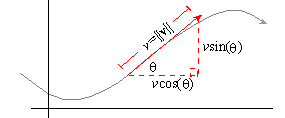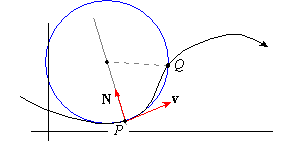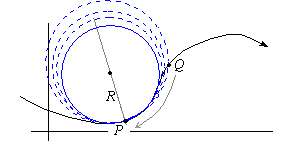Part 2: Curvature in the Plane
If r( t) is the parametrization of a
2-dimensional curve, then its velocity can be written in polar form as
|
v =
á vcos( q) ,vsin( q)
ñ |
|

Factoring out the v then leads to v = v
á cos(q) ,sin( q)
ñ , which reveals
that the unit vector is
|
T =
á cos[ q( t) ] ,sin[ q( t) ]
ñ |
|
As a result, the derivative of T is given by
|
|
= |
 |
|
cos[ q(t) ] , |
|
sin[ q( t) ] |
 |
|
|
= |
 |
-sin[ q( t) ] |
|
,cos[ q( t) ] |
|
 |
|
|
= |
|
|
Since
á -sin( q) ,cos( q)
ñ is also a unit vector, the magnitude of dT/dt is
which via the chain rule is equivalent to
We define dq/ds to be the curvature k of the curve.
That is,
Since v = ds/dt, solving for dq/ds in (4)
yields the formula
EXAMPLE 2 Find the curvature k of the curve r( t) =
á t,ln| sec( t) |
ñ
Solution: The velocity is v =
á 1,tan(t)
ñ , so that the speed is
and consequently, the unit tangent vector is
|
T = |
|
á 1,tan(t)
ñ =
á cos( t) ,sin(t)
ñ |
|
and the derivative of the unit tangent is
As a result, (5) implies that the curvature is
To better understand the concept of curvature, let us suppose that
N is normal to a curve at a point P and suppose that we draw a
circle with center on the line through N which passes through P
and Q where Q is another point on the curve.

If we let Q get closer and closer to P, the result will be a sequence of
circles which converge to a circle of radius R called the osculating
circle at point P.

The osculating circle is practically the same as a small section of the
curve, so that if we let Dq denote the change in angle between
the velocity vectors v( t) and v(t+Dt) for Dt small, then elementary geometry implies
that Dq is also the angle of the sector between r( t) and r( t+Dt) .

Thus, if Ds denotes the length of the arc of that sector, then Ds = RDq, which implies that
so that in the limit as Ds approaches 0, the ratio Dq/Ds approaches the curvature k. As a result, it follows that
the curvature is given by
That is, the curvature k( t) is the reciprocal of the
radius of the osculating circle.
As a result, the curvature of a circle is constant, and indeed,
Likewise, it follows that the curvature of a straight line is k = 0.
EXAMPLE 3 Find the curvature of the circle of radius 3
parametrized by
|
r( t) =
á 3cos( t) ,3sin(t)
ñ |
|
Solution: Since the velocity is v( t) =
á -3sin( t) ,3cos( t)
ñ ,
the speed is
As a result, the unit tangent vector is
|
T( t) =
á -sin( t) ,cos(t)
ñ |
|
from which it follows that
As a result, the curvature is
Check your Reading: How is the curvature in example 3 related to the radius of the circle?








